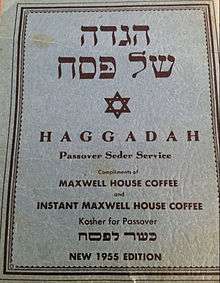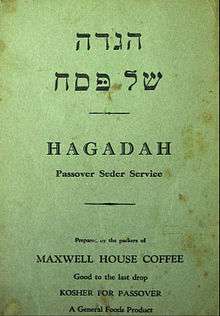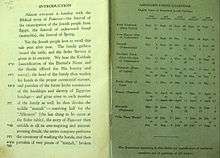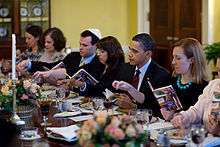Maxwell House Haggadah

The Maxwell House Haggadah is an English-Hebrew Passover Haggadah introduced by the Maxwell House company as a marketing promotion in 1932 and printed continuously since that time. With over 50 million copies in print, it is the best known and most popular Haggadah among American Jews, and is considered a cultural icon. It is used at Passover Seders in private homes, schools, senior centers, prisons, and the United States Army, and is the Haggadah of choice for the White House Passover Seder conducted yearly by President Obama from 2009 to 2016. In 2011 a new English translation replaced the archaic phrases in the original and also incorporated gender-neutral language.
History


The Maxwell House Haggadah debuted in 1932 as part of a marketing campaign for Maxwell House kosher for Passover coffee by Joseph Jacobs Advertising.[1] A copy was distributed in-store with every purchase of Maxwell House coffee.[2] While other kosher for Passover food companies – such as Manischewitz and Streit's – also distributed their own Haggadah, the Maxwell House Haggadah became the best known and most widely used in American Jewish homes. Balin contends that this popularity was due to three factors:[2]
- The growing need for a Haggadah by American Jews interested in conducting a Passover Seder but having little familiarity with religious observance
- The easy availability of the Maxwell House Haggadah, acquired via "a trip to the local supermarket"
- The simple, "user-friendly" English and Hebrew layout
Fenster notes that until the introduction of the Maxwell House Haggadah, American families purchased new and different Haggadahs each year for their Passover Seder guests. The easy availability and textual consistency of each year's Maxwell House Haggadah made it ideal for expanding the family's Haggadah collection.[3]
The 1932 edition gave equal prominence to the Hebrew and English texts, placing them in parallel columns, and conveyed authenticity and adherence to tradition by opening from right to left in the manner of a Hebrew book.[4] Instructions for conducting the Seder appeared on the English side only and references to biblical verses cited in the text were on the Hebrew side.[5] Then as now, the Haggadah presents only the text and directions for conducting the Seder, without exegesis.[6]
The English translation, which prevailed from the Haggadah's inception until its re-translation in 2011, contained "formal 'thees' and 'thous', masculine God language, and gender-specific references to a male reader".[5] The limited illustrations in the original were from the 1695 Amsterdam Haggadah,[5][7] rendered in neoclassical style.[8] An advertisement for Maxwell House coffee appeared on the inside back cover.[9]
In the 1960s a "DeLuxe" edition with an azure cover was introduced.[10] This edition also initiated an Ashkenazic transliteration for those who could not read the Hebrew text.[11][12] The inside layout underwent additional graphics changes every decade on average.[12] In 2000 the Haggadah switched its illustrations from sketches to photographs of a multigenerational family sitting at their Seder table. The cover similarly showed these models, a move away from the monochrome covers of the previous 40 years. According to Joseph Jacobs Advertising, this emphasis on the traditional look of a Passover Seder was in response to the trend of American Jews dissociating from religious observance.[13]
Gender-neutral translation
In 2011, the Maxwell House Haggadah introduced a new English translation which replaced the archaic phrases in the original and also incorporated gender-neutral language.[1] The 58-page reissue replaced the formal thee, thou, wherefore, and saith with You, why, and say.[12] It refers to God as "Monarch" instead of "King" and as "Parent" instead of "Father", and replaces the familiar "Four Sons" with "four different sorts of children".[1][12] The translation was done by Henry Frisch of Teaneck, New Jersey, a former high school teacher of English. No alterations were made in the traditional Hebrew text.[1]
Cultural icon
Originally a "dull green", the cover was switched to an azure background in the 1960s.[5] This Haggadah, featuring the "Good to the Last Drop" logo and the words "Maxwell House Haggadah" on a plain blue background, became a cultural icon.[14] In 1997 the Hallmark company reproduced the blue Maxwell House Haggadah cover on one of its Passover greeting cards with the greeting, "Wishing you a Passover filled with all your favorite traditions". On the reverse, Hallmark described Maxwell House Haggadahs as "cultural icons – prized family possessions that have been handed down through the generations and are a warm reminder of the past".[14]
Due to its ubiquity and long publishing history, the Maxwell House Haggadah is a fond tradition for many people who remember using it at Passover Seders in their childhood homes.[15][16]
Distribution and use

The Maxwell House Haggadah is "the most widely used Haggadah in the world",[17] with an estimated 50 million copies in print.[1] One million copies were distributed in 2006,[17] as were one million copies of the revised, gender-neutral translation in 2011.[1] The Maxwell House Haggadah is distributed in national U.S. supermarket chains such as A&P and King Kullen,[14] at Shop-Rite and Pathmark stores serving Jewish neighborhoods in the northeastern United States,[1] and at independent groceries.[14] Each copy is available with the purchase of a can of Maxwell House coffee.[17] Between 5,000 and 10,000 copies are also mailed to customers who pay for shipping and handling.[14]
The Maxwell House Haggadah is used at Passover Seders in private homes, schools, senior centers, and prisons. The United States Army has issued it to soldiers in every military campaign since the 1930s.[14] It was reportedly used in underground Seders in the Soviet Union,[12] and is the Haggadah of choice for President Barack Obama's White House Passover Seder, which he conducted annually from 2009 to 2016.[1][18][19]
References
Notes
- 1 2 3 4 5 6 7 8 Berger, Joseph (8 April 2011). "Giving a Haggadah a Makeover". The New York Times. Retrieved 18 April 2016.
- 1 2 Balin 2008, pp. 87–88.
- ↑ "The Genius Marketing Idea That Put Maxwell House On Every Passover Table". Fast Company. 22 March 2013. Retrieved 18 April 2016.
- ↑ Steinberg 2015, p. 93.
- 1 2 3 4 Balin 2008, p. 88.
- ↑ "Local translator updates Maxwell House Haggadah". New Jersey Jewish Standard. 1 April 2011. Retrieved 18 April 2016.
- ↑ Chiswick 2014, p. 99.
- ↑ Steinberg 2015, pp. 93–94.
- ↑ Steinberg 2015, p. 94.
- ↑ Balin 2008, pp. 88–89.
- ↑ Balin 2008, p. 89.
- 1 2 3 4 5 Lipman, Steve (21 March 2011). "Good to the Last Dayenu". The Jewish Week. Retrieved 18 April 2016.
- ↑ Steinberg 2015, p. 111.
- 1 2 3 4 5 6 Balin 2008, p. 86.
- ↑ O'Malley, Michael (22 April 2011). "For some Jewish families, it's not Passover without Maxwell House". The Plain Dealer. Retrieved 18 April 2016.
- ↑ Oppenheimer, Mark (2 April 2007). "Haggadah Better Idea: Let's stop improving Passover". Slate. Retrieved 18 April 2016.
- 1 2 3 Balin 2008, p. 85.
- ↑ Steinberg 2015, p. 114.
- ↑ Sweet, Lynn (6 April 2015). "Obama 2015 Passover Seder: Guests, menu & Maxwell House Haggadah". Chicago Sun-Times. Retrieved 18 April 2016.
Sources
- Balin, Carole B. (2008). "'Good to the Last Drop': The proliferation of the Maxwell House Haggadah". In Arnow, David. My People's Passover Haggadah: Traditional texts, modern commentaries. 1. Jewish Lights Publishing. ISBN 1580233546.
- Chiswick, Carmel (2014). Judaism in Transition: How economic choices shape religious tradition. Stanford University Press. ISBN 0804791414.
- Steinberg, Kerri P. (2015). Jewish Mad Men: Advertising and the design of the American Jewish experience. Rutgers University Press. ISBN 0813563771.